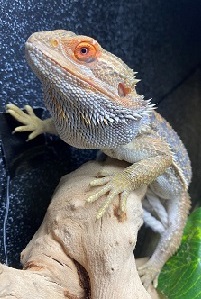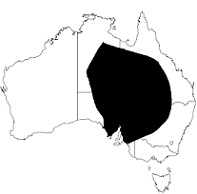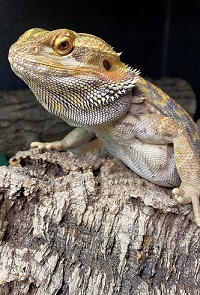Inland Bearded Dragon
Pogona vitticeps
- Habitat: Arid woodlands
- Range: Central and eastern Australia
- Natural Diet: Plant matter, insects, other invertebrates, and small mammals
- Status in the Wild: Common
All about the Inland Bearded Dragon
Inland Bearded Dragons are found in arid
woodland habitats in eastern and central Australia. They are habitat
generalists and are opportunist omnivores feeding on insects, plant
matter, and small mammals. They are not picky eaters.
Behavior
Inland Bearded Dragons, like chameleons, can modulate coloring with changing moods. While defending themselves from predators, they flatten their bodies and open their mouths, puffing up their guttural pouches with beards stretched outward. The defensive mood influences a change in the color of the guttural pouches, which darken. The guttural pouches of the males also darken during the breeding season, becoming almost black during their courtship displays.
Inland Bearded Dragons do not vocalize but make soft hissing sounds when attacked. Their modes of communication are through the changing of skin color, and exhibiting a selection of postures and/or physical gestures. They bob their heads or wave their arms to interact with more dominant Bearded Dragons.
Reproduction
They reach sexual maturity between one to two years of age. Males
tend to be more aggressive during the breeding season and compete
with other males for females. Breeding takes place during spring and
summer, which in Australia is between September and March. Females
dig burrows in which they lay clutches of eggs. Each clutch contains
24 eggs and each female can lay up to nine clutches a year.


